Towards Digital Transformation of Agriculture for Sustainable Development in China: Experience and Lessons Learned
Abstract
:1. Introduction
1.1. Research Objectives
1.2. Research Contributions
2. Major Challenges of Agriculture in China
2.1. Cropland Scarcity and National Food Security
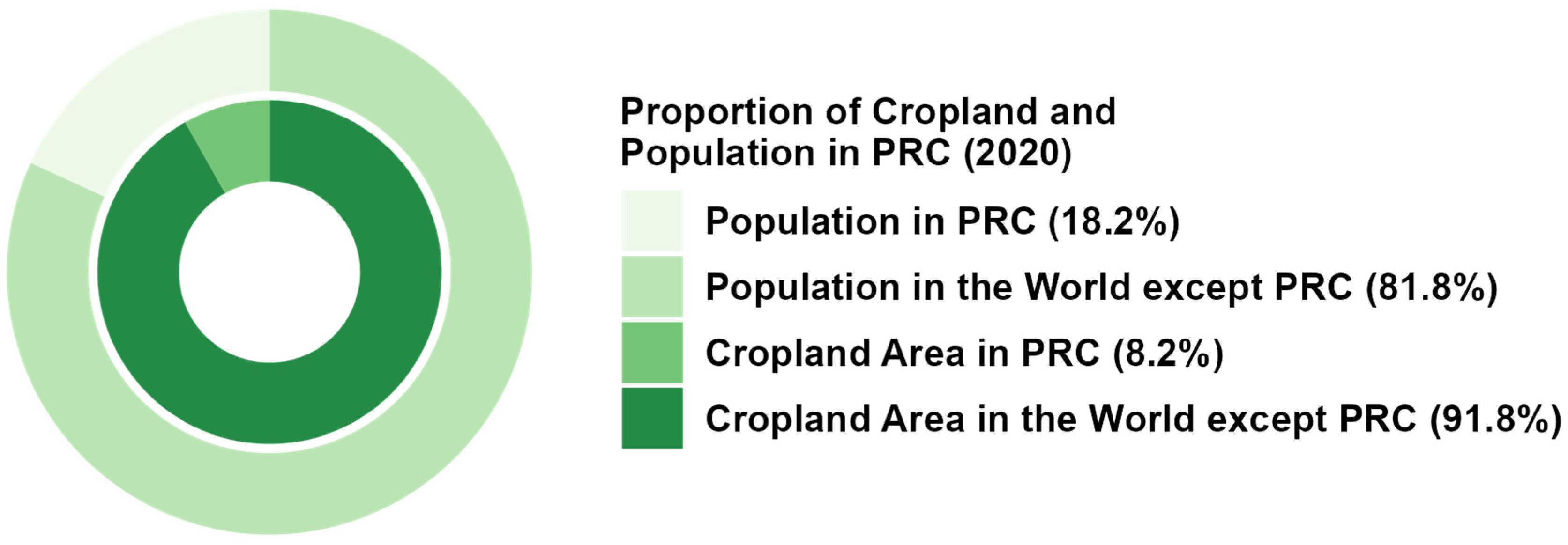
2.2. Low Educational Level of Rural Labor
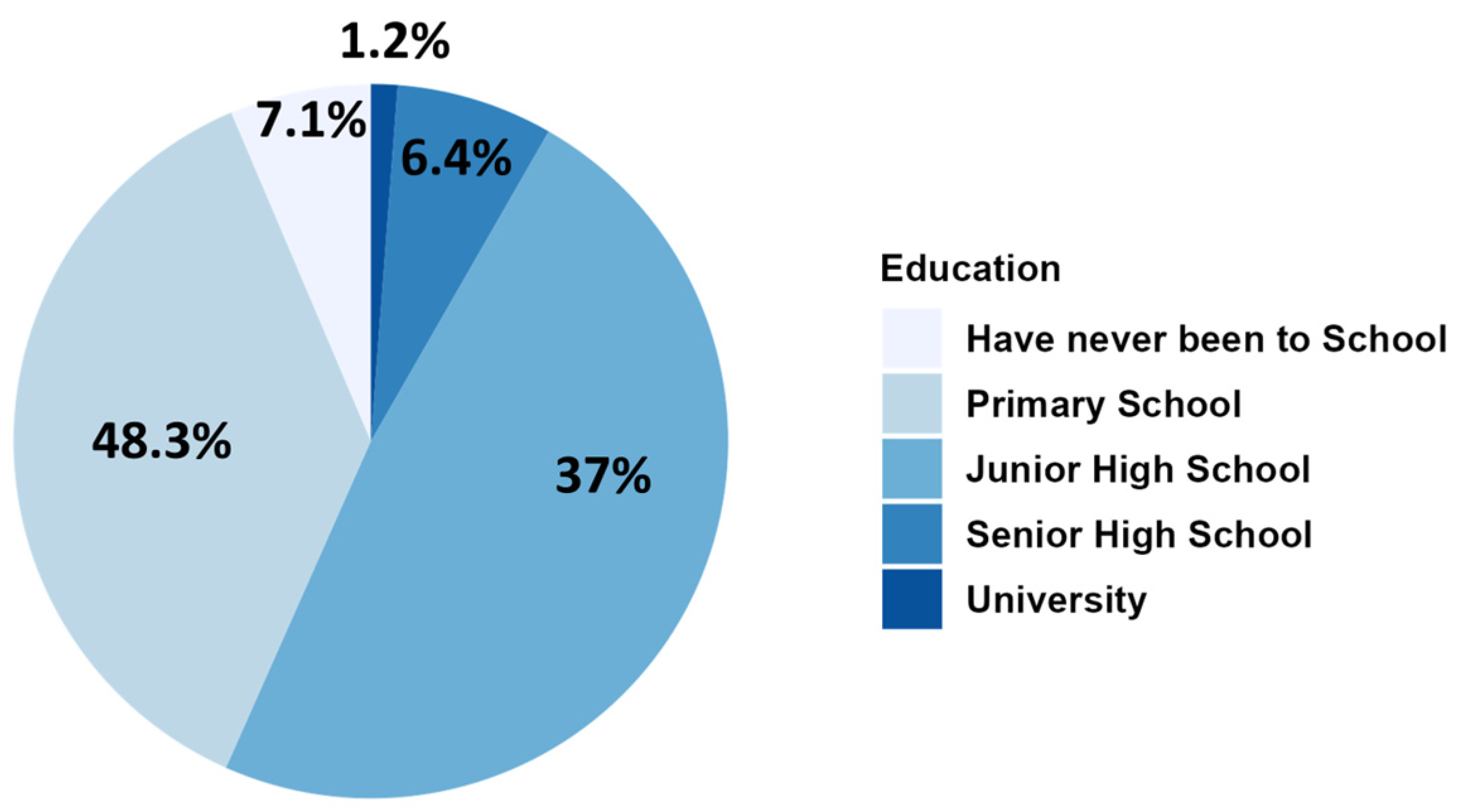
2.3. Aging Population

2.4. Loss of Rural Labor from Urbanization
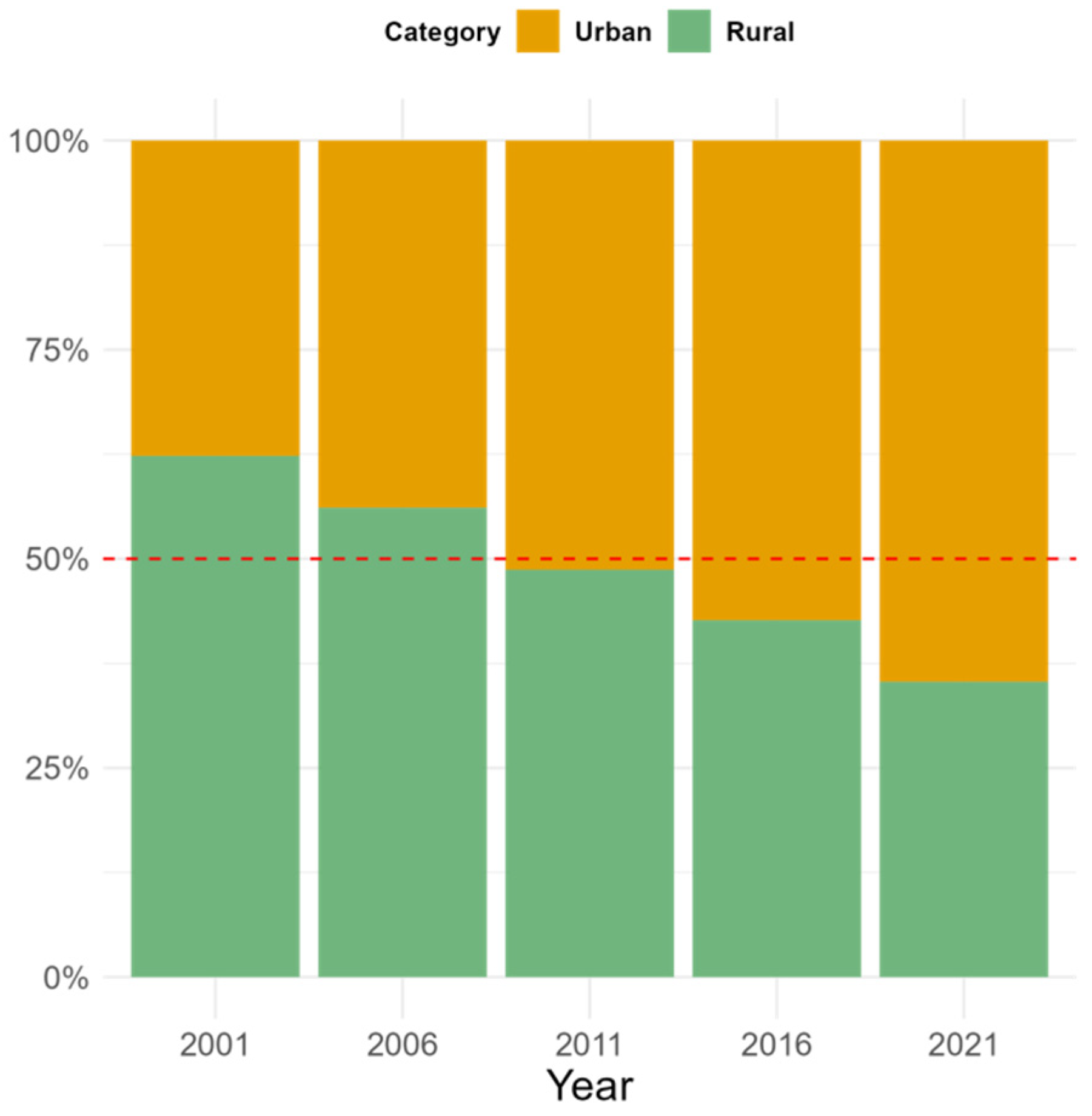
2.5. Rise in Rural Labor Costs
2.6. Scarcity of Water
2.7. Non-Point Source Pollution from Chemical Fertilizers
3. The Progress of Digital Transformation of Agriculture in China
3.1. The Understanding of Digital Transformation of Agriculture in China
- Hardware equipment: This involves the deployment of sensors and controllers for real-time data collection across various aspects of agricultural operations such as soil moisture, temperature, crop growth stages, and livestock health.
- Cloud-based systems: Digital transformation involves utilizing cloud-based platforms for storing and processing the vast amount of data collected from the field. These systems enable seamless data access and sharing among stakeholders involved in agricultural decision-making.
- Software systems: In the era of the digital economy, data have become a novel productivity factor [75]. Advanced data analysis techniques are now employed to derive actionable insights, promoting a sustainable agricultural food system [76]. Decision-making recommendations generated by these software systems assist farmers and agricultural stakeholders in optimizing resource allocation, crop management, and risk mitigation strategies.
- Mobile applications: Mobile applications serve as user-friendly interfaces for accessing and interacting with the digital system. Through these applications, farmers can monitor agricultural operations remotely, receive real-time alerts, and make informed decisions on-the-go using their smartphones.
3.2. Key Figures of Digital Transformation of Agriculture in China

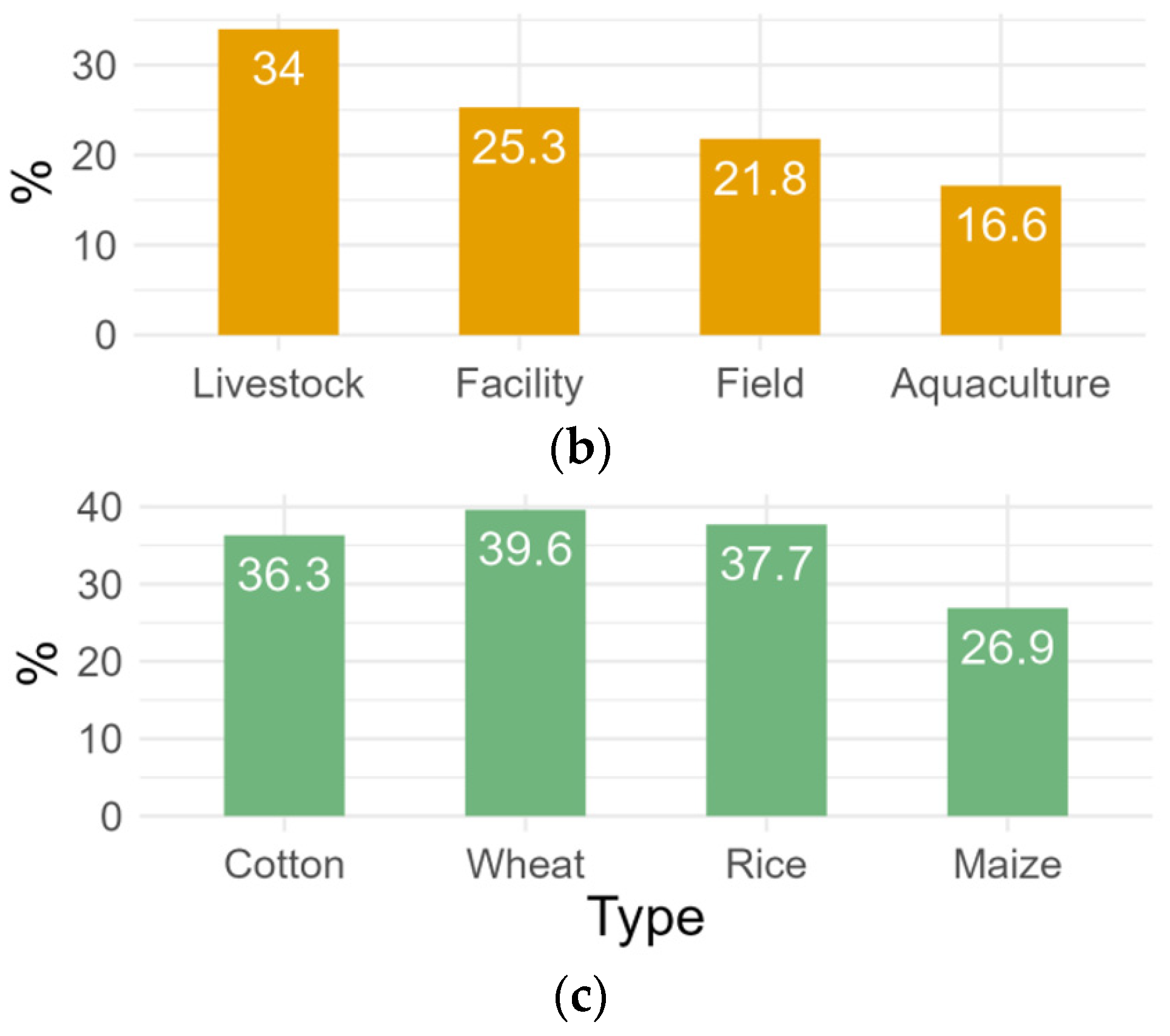
3.3. Comparison of China’s Agricultural Digital Transformation with That of Other Countries
4. Relationship Between Digital Transformation and Sustainable and Environmentally Friendly Practices
4.1. Chemical Fertilizer Reduction by Digital Transformation
4.2. Water Saving by Digital Transformation
4.3. Agricultural Carbon Emission Mitigation by Digital Transformation
4.4. Inclusion of Smallholder Farming Within Large-Scale Production Systems by Digital Transformation
5. How the Implementation of Digital Transformation in Sustainable Agriculture Contributes to Both Green and Social Inclusiveness in China
5.1. Promotion of Digital Literacy from Digital Transformation
5.2. Reduction in Workload from Digital Transformation
5.3. Creation of Job Opportunities for Low-Skilled Labor Through Digital Transformation
5.4. Development of Rural Inclusive Finance from Digital Transformation
6. Provision of Evidence-Based Policy Recommendations
6.1. Improvement of Agricultural Digital Infrastructure
6.2. Construction of Large Agricultural Databases and Platforms
6.3. Promotion of Digital Agricultural Technologies
6.4. Establishment of Policy Evaluation Mechanism
6.5. Safeguard of Cybersecurity
7. Conclusions
Supplementary Materials
Author Contributions
Funding
Data Availability Statement
Conflicts of Interest
References
- Glantz, M.; Gommes, R.; Ramasamy, S. Coping with a Changing Climate: Considerations for Adaptation and Mitigation in Agriculture. Chapter 5: Short-Term and Long-Term Policy Options. Environment and Natural Resources Management Series, Monitoring and Assessment—Food and Agriculture Organization of the United Nations. 2009. Available online: https://www.fao.org/3/i1315e/i1315e05.pdf (accessed on 1 April 2024).
- Chandio, A.; Ozdemir, D.; Gokmenoglu, K.; Usman, M.; Jiang, Y. Digital agriculture for sustainable development in China: The promise of computerization. Technol. Soc. 2024, 76, 102479. [Google Scholar] [CrossRef]
- Huang, J.; Su, L.; Huang, Q.; Liu, X. Facilitating inclusive ICT application and e-Commerce development in rural China. Agric. Econ. 2022, 53, 938–952. [Google Scholar] [CrossRef]
- Yang, B.; Wang, X.; Wu, T.; Deng, W. Reducing farmers’ poverty vulnerability in China: The role of digital financial inclusion. Rev. Dev. Econ. 2023, 27, 1445–1480. [Google Scholar] [CrossRef]
- Wijerathna-Yapa, A.; Henry, R.; Dunn, M.; Beveridge, C. Science and opinion in decision making: A case study of the food security collapse in Sri Lanka. Mod. Agric. 2023, 1, 142–151. [Google Scholar] [CrossRef]
- Zhang, Z.; Abdullah, M.; Xu, G.; Matsubae, K.; Zeng, X. Countries’ vulnerability to food supply disruptions caused by the Russia–Ukraine war from a trade dependency perspective. Sci. Rep. 2023, 13, 16591. [Google Scholar] [CrossRef] [PubMed]
- UNESCAP. Ready for the Dry Years Building Resilience to Drought in South-East Asia. 2020. Available online: https://www.unescap.org/sites/default/files/publications/Ready%20for%20the%20Dry%20Years.pdf (accessed on 1 April 2024).
- ADB. El Niño, Poor Water Management, and Climate Change Bringing Droughts to Asia and the Pacific. 2016. Available online: https://www.adb.org/news/features/el-nino-poor-water-management-and-climate-change-bringing-droughts-asia-and-pacific (accessed on 1 April 2024).
- Aryal, J. Contribution of Agriculture to Climate Change and Low-Emission Agricultural Development in Asia and the Pacific. ADBI Working Papers. 2022. Available online: https://www.adb.org/publications/contribution-of-agriculture-to-climate-change-and-low-emission-agricultural-development-in-asia-and-the-pacific (accessed on 1 April 2024).
- Walter, A.; Finger, R.; Huber, R.; Buchmann, N. Smart farming is key to developing sustainable agriculture. Proc. Natl. Acad. Sci. USA 2017, 114, 6148–6150. [Google Scholar] [CrossRef]
- Newell, P.; Taylor, O. Contested landscapes: The global political economy of climate-smart agriculture. J. Peasant. Stud. 2017, 45, 108–129. [Google Scholar] [CrossRef]
- Aubert, B.; Schroeder, A.; Grimaudo, J. IT as enabler of sustainable farming: An empirical analysis of farmers’ adoption decision of precision agriculture technology. Decis. Support Syst. 2012, 54, 510–520. [Google Scholar] [CrossRef]
- Wolfert, S.; Ge, L.; Verdouw, C.; Bogaartd, M.-J. Big data in smart farming-A review. Agric. Syst. 2017, 153, 69–80. [Google Scholar] [CrossRef]
- Phalan, B.; Onial, M.; Balmford, A.; Green, R.E. Reconciling food production and biodiversity conservation: Land sharing and land sparing compared. Science 2011, 333, 1289–1291. [Google Scholar] [CrossRef]
- Qin, T.; Wang, L.; Zhou, Y.; Guo, L.; Jiang, G.; Zhang, L. Digital technology-and-services-driven sustainable transformation of agriculture: Cases of China and the EU. Agriculture 2022, 12, 297. [Google Scholar] [CrossRef]
- Fernando, A.J. How Africa is promoting agricultural innovations and technologies amidst the COVID-19 pandemic. Mol. Plant 2020, 13, 1345–1346. [Google Scholar] [CrossRef] [PubMed]
- Abate, G.T.; Abay, K.A.; Chamberlin, J.; Kassim, Y.; Spielman, D.J.; Tabe-Ojong, M.P.J. Digital tools and agricultural market transformation in Africa: Why are they not at scale yet, and what will it take to get there? Food Policy 2023, 116, 102439. [Google Scholar] [CrossRef]
- Klerkx, L.; Jakku, E.; Labarthe, P. A review of social science on digital agriculture, smart farming and agriculture 4.0: New contributions and a future research agenda. NJAS-Wagening. J. Life Sci. 2019, 90, 100315. [Google Scholar] [CrossRef]
- Kasztelan, A.; Nowak, A. Green growth in agriculture-New measurement concept and its empirical verification. Sustain. Dev. 2024, 32, 325–335. [Google Scholar] [CrossRef]
- Meng, Y.U.E.; Li, W.J.; Shan, J.I.N.; Jing, C.H.E.N.; Chang, Q.; Glyn, J.O.N.E.S.; Cao, Y.Y.; Yang, G.J.; Li, Z.H.; Frewer, L.J. Farmers’ precision pesticide technology adoption and its influencing factors: Evidence from apple production areas in China. J. Integr. Agric. 2022, 22, 292–305. [Google Scholar]
- Ma, S.; Li, J.; Wei, W. The carbon emission reduction effect of digital agriculture in China. Environ. Sci. Pollut. Res. 2022, 1–18. [Google Scholar] [CrossRef]
- Shi, L.; Shi, G.; Qiu, H. General review of intelligent agriculture development in China. China Agric. Econ. Rev. 2019, 11, 39–51. [Google Scholar] [CrossRef]
- Liu, L.; Liu, K. Can digital technology promote sustainable agriculture? Empirical evidence from urban China. Cogent Food Agric. 2023, 9, 2282234. [Google Scholar] [CrossRef]
- Lin, J.; Mao, M. How does digital transformation affect sustainable innovation performance? The pivotal roles of digital technology-business alignment and environmental uncertainty. Sustain. Dev. 2023, 32, 3163–3181. [Google Scholar] [CrossRef]
- Li, L.; Lin, J. Digital transformation for the sustainable development of firms: The role of green capability and green culture. Sustain. Dev. 2024, 32, 1861–1875. [Google Scholar] [CrossRef]
- Shen, J.; Zhang, F.; Siddique, K. Sustainable resource use in enhancing agricultural development in China. Engineering 2018, 4, 588–589. [Google Scholar] [CrossRef]
- Pandey, P.C.; Pandey, M. Highlighting the role of agriculture and geospatial technology in food security and sustainable development goals. Sustain. Dev. 2023, 31, 3175–3195. [Google Scholar] [CrossRef]
- Lu, F.; Wang, S. Research on the Development Level of Digital Agriculture in China. Stat. Theory Pract. 2022, 3, 3–9. [Google Scholar]
- Zhang, Z.; Li, Y.; Elahi, E.; Wang, Y. Comprehensive evaluation of agricultural modernization levels. Sustainability 2022, 14, 5069. [Google Scholar] [CrossRef]
- Zhu, M.; Li, Y.; Khalid, Z.; Elahi, E. Comprehensive evaluation and promotion strategy of agricultural digitalization level. Sustainability 2023, 15, 6528. [Google Scholar] [CrossRef]
- Zhao, J.; Wang, S. Comprehensive evaluation of the development level of agricultural digital economy at the provincial level in China. China Agric. Inf. 2023, 35, 77–87. [Google Scholar]
- Dong, X.; Xu, J. Comprehensive evaluation of the high-quality development level of digital agriculture in China. Mod. Agric. Res. 2022, 28, 11–15. [Google Scholar]
- Dayıoğlu, M.A.; Turker, U. Digital transformation for sustainable future-agriculture 4.0: A review. J. Agric. Sci. 2021, 27, 373–399. [Google Scholar] [CrossRef]
- Hrustek, L. Sustainability driven by agriculture through digital transformation. Sustainability 2020, 12, 8596. [Google Scholar] [CrossRef]
- Lin, Y.; Li, C. Towards sustainable development: Research on the green growth effect of digital agriculture in China. Environ. Sci. Pollut. Res. 2023, 1–14. [Google Scholar] [CrossRef]
- Jiang, S.; Zhou, J.; Qiu, S. Digital agriculture and urbanization: Mechanism and empirical research. Technol. Forecast. Soc. Change 2022, 180, 121724. [Google Scholar] [CrossRef]
- Qi, J.; Zheng, X.; Guo, H. The formation of Taobao villages in China. China Econ. Rev. 2019, 53, 106–127. [Google Scholar] [CrossRef]
- Page, M.J.; McKenzie, J.E.; Bossuyt, P.M.; Boutron, I.; Hoffmann, T.C.; Mulrow, C.D.; Shamseer, L.; Tetzlaff, J.M.; Akl, E.A.; Brennan, S.E.; et al. The PRISMA 2020 statement: An updated guideline for reporting systematic reviews. BMJ 2021, 372, n71. [Google Scholar] [CrossRef] [PubMed]
- The Central People’s Government of the People’s Republic of China. The Food Security Guarantee Law of the People’s Republic of China. Available online: https://www.gov.cn/yaowen/liebiao/202312/content_6923387.htm (accessed on 23 March 2025).
- FAOSTAT. Food and Agriculture Data. 2025. Available online: https://www.fao.org/faostat/en/#home (accessed on 23 March 2025).
- Hannum, E. Poverty and basic education in rural China: Villages, households, and girls’ and boys’ enrollment. Comp. Educ. Rev. 2003, 47, 141–159. [Google Scholar] [CrossRef]
- National Bureau of Statistics in China. Communiqué on the Major Data of the Third National Agricultural Census (No. 5). 2017. Available online: https://www.stats.gov.cn/sj/tjgb/nypcgb/qgnypcgb/202302/t20230206_1902105.html (accessed on 23 March 2025).
- The Central People’s Government of the People’s Republic of China. Study of the “Decision” Daily Q&A|How to Understand Actively Responding to Population Aging, Improving the Development of Elderly Care Services and the Policy Mechanisms for the Elderly Care Industry. Available online: https://www.gov.cn/zhengce/202410/content_6983026.htm (accessed on 23 March 2025).
- United Department of Economic and Social Affairs. World Population Prospects 2022. 2024. Available online: https://population.un.org/wpp/ (accessed on 1 April 2024).
- Cohen, S.A.; Greaney, M.L. Aging in rural communities. Curr. Epidemiol. Rep. 2023, 10, 1–16. [Google Scholar] [CrossRef] [PubMed]
- Ren, C.; Zhou, X.; Wang, C.; Guo, Y.; Diao, Y.; Shen, S.; Reis, S.; Li, W.; Xu, J.; Gu, B. Ageing threatens sustainability of smallholder farming in China. Nature 2023, 616, 96–103. [Google Scholar] [CrossRef]
- Liu, J.; Fang, Y.; Wang, G.; Liu, B.; Wang, R. The aging of farmers and its challenges for labor-intensive agriculture in China: A perspective on farmland transfer plans for farmers’ retirement. J. Rural. Stud. 2023, 100, 103013. [Google Scholar] [CrossRef]
- Lv, M. Improving the Rural Elderly Care Service System and Actively Responding to Rural Population Aging—Special Interpretation of the 2024 Central No. 1 Document. 2024. Available online: https://m.thepaper.cn/baijiahao_26774583 (accessed on 23 March 2025).
- Cao, S.; Yu, N.; Wu, Y.; Wang, Z.; Mi, J. The educational level of rural labor, population urbanization, and sustainable economic growth in China. Sustainability 2020, 12, 4860. [Google Scholar] [CrossRef]
- Tai’an Municipal Bureau of Statistics. The Situation, Causes, and Countermeasures of Rural Young and Middle-Aged Labor Loss in Tai’an City. Available online: https://tjj.taian.gov.cn/art/2018/6/7/art_46884_4133652.html (accessed on 23 March 2025).
- Goyal, S.K.; Prabha, S.S.; Rai, J.P.; Singh, S.N. Agricultural mechanization for sustainable agricultural and rural development in Eastern UP-A review. Agric. Sustain. Dev. 2014, 2, 192–198. [Google Scholar]
- National Bureau of Statistics in China. Statistical Bulletin of National Economic and Social Development. Available online: https://www.stats.gov.cn/sj/tjgb/ndtjgb/ (accessed on 1 April 2024).
- Tian, X.; Yi, F.; Yu, X. Rising cost of labor and transformations in grain production in China. China Agric. Econ. Rev. 2020, 12, 158–172. [Google Scholar] [CrossRef]
- Ministry of Agriculture and Rural Affairs of the People’s Republic of China. Notice on Printing and Distributing the “Guidelines for Digital Construction of Agricultural Modernization Demonstration Zones”. Available online: https://www.moa.gov.cn/govpublic/SCYJJXXS/202209/t20220905_6408568.htm (accessed on 23 March 2025).
- Chowdhury, M.R.; Sourav, M.S.U.; Sulaiman, R.B. The role of digital agriculture in transforming rural areas into smart villages. In Technology and Talent Strategies for Sustainable Smart Cities; Emerald Publishing Limited: Bingley, UK, 2023; pp. 57–78. [Google Scholar]
- National Bureau of Statistics in China. Statistical Bulletin of National Economic and Social Development. 2010. Available online: https://zgsn.ahu.edu.cn/2011/1228/c17129a233124/pagem.htm (accessed on 1 April 2024).
- National Bureau of Statistics in China. Statistical Bulletin of National Economic and Social Development. 2015. Available online: https://www.gov.cn/xinwen/2016-04/28/content_5068727.htm (accessed on 1 April 2024).
- National Bureau of Statistics in China. Statistical Bulletin of National Economic and Social Development. 2020. Available online: https://www.gov.cn/xinwen/2021-04/30/content_5604232.htm (accessed on 1 April 2024).
- National Bureau of Statistics in China. Statistical Bulletin of National Economic and Social Development. 2022. Available online: https://www.gov.cn/lianbo/2023-04/28/content_5753682.htm (accessed on 1 April 2024).
- Jiang, Y. China’s water scarcity. J. Environ. Manag. 2009, 90, 3185–3196. [Google Scholar] [CrossRef]
- Huang, G.; Hoekstra, A.; Krol, M.; Jägermeyr, J.; Galindo, A.; Yu, C.; Wang, R. Water-saving agriculture can deliver deep water cuts for China. Resour. Conserv. Recycl. 2020, 154, 104578. [Google Scholar] [CrossRef]
- Li, Y.; Huan, M.; Jiao, X.; Chi, L.; Ma, J. The impact of labor migration on chemical fertilizer use of wheat smallholders in China- mediation analysis of socialized service. J. Clean. Prod. 2023, 394, 136366. [Google Scholar] [CrossRef]
- Tsachidou, B.; Scheuren, M.; Gennen, J.; Debbaut, V.; Toussaint, B.; Hissler, C.; George, I.; Delfoss, P. Biogas residues in substitution for chemical fertilizers: A comparative study on a grassland in the Walloon Region. Sci. Total Environ. 2019, 666, 212–225. [Google Scholar] [CrossRef]
- Luo, M.; Liu, X.; Legesse, N.; Liu, Y.; Wu, S.; Han, F.; Ma, Y. Evaluation of agricultural non-point source pollution: A review. Water Air Soil Pollut. 2023, 234, 657. [Google Scholar] [CrossRef]
- Ministry of Agriculture, China. Action Plan for Zero Growth in Chemical Fertilizers Use. 2015. Available online: http://www.moa.gov.cn/ztzl/mywrfz/gzgh/201509/t20150914_4827907.htm (accessed on 1 April 2024).
- Wang, M.; Jiang, T.; Mao, Y.; Wang, F.; Yu, J.; Zhu, C. Current situation of agricultural non-point source pollution and its control. Water Air Soil Pollut. 2023, 234, 471. [Google Scholar] [CrossRef]
- Gill, S.S.; Chana, I.; Buyya, R. IoT based agriculture as a cloud and big data service: The beginning of digital India. J. Organ. End User Comput. 2017, 29, 1–23. [Google Scholar] [CrossRef]
- FAO. Digital Technologies in Agriculture and Rural Areas; Food and Agriculture Organization of the United Nations: Rome, Italy, 2019. [Google Scholar]
- Rotz, S.; Duncan, E.; Small, M.; Botschner, J.; Dara, R.; Mosby, I.; Reed, M.; Fraser, E. The Politics of Digital Agricultural Technologies: A Preliminary Review. Sociol. Rural. 2019, 59, 203–229. [Google Scholar] [CrossRef]
- Benke, K.; Tomkins, B. Future food-production systems: Vertical farming and controlled-environment agriculture. Sustain. Sci. Pract. Policy 2017, 13, 13–26. [Google Scholar] [CrossRef]
- Ministry of Agriculture and Rural Affairs, China. Digital Rural Development Guide 1.0. 2021. Available online: http://www.moa.gov.cn/hd/zqyj/202301/P020230104556857814615.pdf (accessed on 1 April 2024).
- Ding, J.; Li, J.; Liu, J.; Zhang, W.; Jia, X. ICT-based agricultural advisory services and nitrogen management practices: A case study of wheat production in China. J. Integr. Agric. 2022, 21, 1799–1811. [Google Scholar]
- Khan, N.; Ray, R.L.; Zhang, S.; Osabuohien, E.; Ihtisham, M. Influence of mobile phone and internet technology on income of rural farmers: Evidence from Khyber Pakhtunkhwa Province, Pakistan. Technol. Soc. 2022, 68, 101866. [Google Scholar] [CrossRef]
- Thomas, R.J.; Hare, G.O.; Coyle, D. Understanding technology acceptance in smart agriculture: A systematic review of empirical research in crop production. Technol. Forecast. Soc. Change 2023, 189, 122374. [Google Scholar] [CrossRef]
- Huang, L.; Dou, Y.; Liu, Y.; Wang, J.; Chen, G.; Zhang, X.; Wang, R. Toward a research framework to conceptualize data as a factor of production: The data marketplace perspective. Fundam. Res. 2021, 1, 586–594. [Google Scholar] [CrossRef]
- Scown, M.W.; Winkler, K.J.; Nicholas, K.A. Aligning research with policy and practice for sustainable agricultural land systems in Europe. Proc. Natl. Acad. Sci. USA 2019, 116, 4911–4916. [Google Scholar] [CrossRef] [PubMed]
- Modern Agriculture Platform. MAP 2021 Green Development Report. 2022. Available online: https://www.researchgate.net/publication/368831333_MAP_2021_Green_Development_Report_Syngenta_Group_China (accessed on 1 April 2024).
- Ministry of Agriculture and Rural Affairs, China. 2019 Report on the Assessment of Digital Agriculture and Rural Development Levels in County Areas Nationwide. 2019. Available online: http://www.agri.cn/zt/sznync/sjbg/201904/P020231106396979969596.pdf (accessed on 1 April 2024).
- Ministry of Agriculture and Rural Affairs, China. 2019 China Rural Digital Development Report. 2019. Available online: http://www.ciia.org.cn/upload/editor/file/2019/12/24/6371280235838322664119898.pdf (accessed on 1 April 2024).
- Ministry of Agriculture and Rural Affairs, China. 2020 Report on the Assessment of Digital Agriculture and Rural Development Levels in County Areas Nationwide. 2020. Available online: https://www.gov.cn/xinwen/2020-11/28/content_5565613.htm (accessed on 1 April 2024).
- Ministry of Agriculture and Rural Affairs, China. 2021 Report on the Assessment of Agricultural and Rural Informatization Development Levels in County Areas Nationwide. 2021. Available online: http://www.moa.gov.cn/xw/zwdt/202112/W020211221365374930266.pdf (accessed on 1 April 2024).
- Ministry of Agriculture and Rural Affairs, China. 2022 China Rural Digital Development Report. 2022. Available online: http://www.scs.moa.gov.cn/zcjd/202304/P020230410575631299102.pdf (accessed on 1 April 2024).
- Askci Consulting Institute. Statistics and Forecast of China’s Smart Agriculture Market Size from 2018 to 2023. 2023. Available online: https://www.askci.com/news/chanye/20230531/163139268552189984335840.shtml (accessed on 1 April 2024).
- Hilten, M.; Wolfert, S. 5G in agri-food—A review on current status, opportunities and challenges. Comput. Electron. Agric. 2022, 201, 107291. [Google Scholar] [CrossRef]
- Kitole, F.A.; Mkuna, E.; Sesabo, J.K. Digitalization and agricultural transformation in developing countries: Empirical evidence from Tanzania agriculture sector. Smart Agric. Technol. 2024, 7, 100379. [Google Scholar] [CrossRef]
- The State Council of the People’s Republic of China. “China’s Digital Rural Development Report (2022)” Released. Available online: https://www.gov.cn/xinwen/2023-03/01/content_5743969.htm (accessed on 29 March 2025).
- People’s Daily Online. “How Far Is the U.S. from ‘Village Internet Connectivity’?”. Available online: http://paper.people.com.cn/rmrbhwb/html/2023-10/10/content_26020858.htm (accessed on 29 March 2025).
- Balmford, B.; Green, R.E.; Onial, M.; Phalan, B.; Balmford, A. How imperfect can land sparing be before land sharing is more favourable for wild species? J. Appl. Ecol. 2018, 56, 73–84. [Google Scholar] [CrossRef]
- Birner, R.; Daum, T.; Pray, C. Who drives the digital revolution in agriculture? A review of supply-side trends, players and challenges. Appl. Econ. Perspect. Policy 2021, 43, 1260–1285. [Google Scholar] [CrossRef]
- He, P.; Xu, X.; Zhou, W.; Smith, W.; He, W.; Grant, B.; Ding, W.; Qiu, S.; Zhao, S. Ensuring future agricultural sustainability in China utilizing an observationally validated nutrient recommendation approach. Eur. J. Agron. 2022, 132, 126409. [Google Scholar] [CrossRef]
- Mao, H.; Liu, S.; Peng, P.; Yang, Z. Digital Extension and Farmers’ Fertilizer Reduction: An Empirical Analysis of China’s Major Apple Producing Areas in Shaanxi Province. Chin. Rural. Econ. 2023, 39, 66–84. [Google Scholar]
- Wu, Y.; Zhang, G.; Chen, G.; Shen, X.; Du, S.; Zhong, Y.; Tang, S.; Gao, X.; Gong, D.; Huang, F. Achievements, situation and opportunities of water saving agriculture in China and projections for future development. Chin. J. Agric. Resour. Reg. Plan. 2021, 42, 1–6. [Google Scholar]
- Henan Daily. Digital Technology in Xixia County Leads a New Trend of Water-Saving Agriculture. 2021. Available online: http://www.moa.gov.cn/xw/qg/202106/t20210630_6370772.htm (accessed on 1 April 2024).
- Shanxi Daily. Shanxi Introduces Comprehensive Reform of Agricultural Water Prices, Precision Subsidies, and Water Conservation Incentives. 2023. Available online: https://www.gov.cn/lianbo/difang/202312/content_6918709.htm (accessed on 1 April 2024).
- Ministry of Water Resources. Guiding Opinions on Promoting the Reform of Water Rights. 2023. Available online: https://www.gov.cn/zhengce/zhengceku/2022-09/01/content_5707831.htm (accessed on 1 April 2024).
- Wang, S.; Yin, C.; Li, F. Innovative incentives can sustainably enhance the achievement of straw burning control in China. Sci. Total Environ. 2023, 857, 159498. [Google Scholar] [CrossRef] [PubMed]
- Prastiyo, S.E.; Irham, I.; Hardyastuti, S.; Jamhari, J. How agriculture, manufacture, and urbanization induced carbon emission? The case of Indonesia. Environ. Sci. Pollut. Res. 2020, 27, 42092–42103. [Google Scholar] [CrossRef] [PubMed]
- Crippa, M.; Solazzo, E.; Guizzardi, D.; Monforti-Ferrario, F.; Tubiello, F.N.; Leip, A. Food systems are responsible for a third of global anthropogenic GHG emissions. Nat. Food 2021, 2, 198–209. [Google Scholar] [CrossRef]
- Jin, S.; Lin, Y.; Niu, K. Driving Green Transformation of Agriculture with Low Carbon: Characteristics of Agricultural Carbon Emissions and Its Emission Reduction Path in China. Reform 2021, 37, 29–37. [Google Scholar]
- OECD; Food and Agriculture Organization of the United Nations. OECD-FAO Agricultural Outlook 2022–2031. 2022. Available online: https://www.oecd-ilibrary.org/agriculture-and-food/oecd-fao-agricultural-outlook-2022–2031_f1b0b29c-en (accessed on 1 April 2024).
- Yu, Y.; Jiang, T.; Li, S.; Li, X.; Gao, D. Energy-related CO2 emissions and structural emissions’ reduction in China’s agriculture: An input–output perspective. J. Clean. Prod. 2020, 276, 124169. [Google Scholar] [CrossRef]
- Zeraibi, A.; Ahmed, Z.; Shehzad, K.; Murshed, M.; Nathaniel, S.P.; Mahmood, H. Revisiting the EKC hypothesis by assessing the complementarities between fiscal, monetary, and environmental development policies in China. Environ. Sci. Pollut. Res. 2022, 29, 23545–23560. [Google Scholar] [CrossRef]
- Chen, Y.; Li, M. How does the digital transformation of agriculture affect carbon emissions? Evidence from China’s provincial panel data. Humanit. Soc. Sci. Commun. 2024, 11, 1–17. [Google Scholar] [CrossRef]
- Lioutas, E.D.; Charatsari, C.; De Rosa, M. Digitalization of agriculture: A way to solve the food problem or a trolley dilemma? Technol. Soc. 2021, 67, 101744. [Google Scholar] [CrossRef]
- Mondejar, M.E.; Avtar, R.; Diaz, H.L.B.; Dubey, R.K.; Esteban, J.; Gomez-Morales, A.; Hallam, B.; Mbungu, N.T.; Okolo, C.C.; Prasad, K. Digitalization to achieve sustainable development goals: Steps towards a Smart Green Planet. Sci. Total. Environ. 2021, 794, 148539. [Google Scholar] [CrossRef] [PubMed]
- Yang, C. Remote sensing and precision agriculture technologies for crop disease detection and management with a practical application example. Engineering 2020, 6, 528–532. [Google Scholar] [CrossRef]
- Zhang, B.; Liu, J.; Zhu, R. Digital Agriculture Development: International Experience, Emission Reduction Effects and Financial Support—Based on the Case Study of Chengdu. Southwest Financ. 2022, 43, 28–39. [Google Scholar]
- Shanjia County, China. Yield Increased by over 300 Kilograms Per Hectare, Carbon Reduction Exceeded 20%! Leveraging Data for Low Carbon and High Productivity in Jiashan’s Agriculture. 2022. Available online: http://www.jiashan.gov.cn/art/2022/12/15/art_1229250583_59046912.html (accessed on 1 April 2024).
- Trivelli, L.; Apicella, A.; Chiarello, F.; Rana, R.; Fantoni, G.; Tarabella, A. From precision agriculture to industry 4.0.: Unveiling technological connections in the agrifood sector. Br. Food J. 2019, 121, 1730–1743. [Google Scholar] [CrossRef]
- Fabregas, R.; Kremer, M.; Schilbach, F. Realizing the potential of digital development: The case of agricultural advice. Science 2019, 366, eaay3038. [Google Scholar] [CrossRef]
- Xie, L.; Luo, B.; Zhong, W. How are smallholder farmers involved in digital agriculture in developing countries: A case study from China. Land 2021, 10, 245. [Google Scholar] [CrossRef]
- Shao, L.; Gong, J.; Fan, W.; Zhang, Z.; Zhang, M. Cost comparison between digital management and traditional management of cotton fields—Evidence from cotton fields in Xinjiang, China. Agriculture 2022, 12, 1105. [Google Scholar] [CrossRef]
- Ministry of Agriculture. Guiding Opinions on the Implementation of the Pilot Work for Subsidies for Scrap and Renewal of Agricultural Machinery in 2012. 2012. Available online: http://www.moa.gov.cn/nybgb/2012/dshiq/201805/t20180516_6142333.htm (accessed on 1 April 2024).
- Zhang, Y.; Yin, Y.; Li, F.; Duan, W.; Xu, K.; Yin, C. Can the outsourcing improve the technical efficiency of wheat production with fertilization and pesticide application? Evidence from China. J. Clean. Prod. 2023, 422, 138587. [Google Scholar] [CrossRef]
- Yang, R.; Liu, J.; Cao, S.; Sun, W.; Kong, F. Impacts of agri-food E-commerce on traditional wholesale industry: Evidence from China. J. Integr. Agric. 2024, 23, 1409–1428. [Google Scholar] [CrossRef]
- Khanna, M.; Atallah, S.S.; Kar, S.; Sharma, B.; Wu, L.; Yu, C.; Chowdhary, G.; Soman, C.; Guan, K. Digital transformation for a sustainable agriculture in the United States: Opportunities and challenges. Agric. Econ. 2022, 53, 924–937. [Google Scholar] [CrossRef]
- Gong, S.; Sun, Z.; Wang, B.; Yu, Z. Could Digital Literacy Contribute to the Improvement of Green Production Efficiency in Agriculture? SAGE Open 2024, 14, 21582440241232789. [Google Scholar] [CrossRef]
- Du, X.; Zhang, J.; Gao, X.; Majid, A. The impact of informatization on agri-income of China’s rural farmers: Ways for digital farming. Front. Sustain. Food Syst. 2024, 8, 1329674. [Google Scholar]
- Li, G. Enhancing Digital Literacy to Support Rural Revitalization. 2022. Available online: http://www.news.cn/tech/20220112/02425f7a52984439a478afd7e3c44fad/c.html (accessed on 1 April 2024).
- Umstätter, C.; Mann, S.; Werner, J. A simple measure for workload as a social sustainability indicator for family farms. Environ. Sustain. Indic. 2022, 14, 100180. [Google Scholar] [CrossRef]
- Wang, Z.; Cao, A.; Lu, H. Does less workload lead to more family educational care? Evidence from rural China. Appl. Econ. Lett. 2024, 2320908. [Google Scholar] [CrossRef]
- Dai, J.; Dong, H. Intensive cotton farming technologies in China: Achievements, challenges and countermeasures. Field Crop. Res. 2014, 155, 99–110. [Google Scholar] [CrossRef]
- ScienceNet. The Yellow River Cotton Region Has “Smart Agriculture That Farmers Can Afford”. 2023. Available online: https://www.cricaas.com.cn/xwdt/mtbd/1c31b2c654cd4289ab225da7dfdf1964.htm (accessed on 1 April 2024).
- Zhang, L.; Chen, S. China’s Digital Economy: Opportunities and Risks. International Monetary Fund Working Paper. 2019. Available online: https://doi.org/10.5089/9781484389706.001 (accessed on 1 April 2024).
- Aweb. Smart Farming: A New Form of Agricultural Intelligence and Digitization. 2019. Available online: http://finance.aweb.com.cn/20230612/661358552.shtml (accessed on 1 April 2024).
- Terence, S.; Purushothaman, G. Systematic review of Internet of Things in smart farming. Trans. Emerg. Telecommun. Technol. 2020, 31, e3958. [Google Scholar] [CrossRef]
- Sun, S.; Lin, S. The impact of digital development on non-agricultural employment of rural women: Evidence from the broadband China strategy. Appl. Econ. 2024, 57, 2224–2240. [Google Scholar] [CrossRef]
- Zheng, X.; Lu, H. Does ICT change household decision-making power of the left-behind women? A Case from China. Technol. Forecast. Soc. Change 2021, 166, 120604. [Google Scholar] [CrossRef]
- China Internet Network Information Center. The 50th Statistical Report on China’s Internet Development. 2022. Available online: https://www.cnnic.net.cn/NMediaFile/2022/0926/MAIN1664183425619U2MS433V3V.pdf (accessed on 1 April 2024).
- Liu, Y.; Liu, C.; Zhou, M. Does digital inclusive finance promote agricultural production for rural households in China? Research based on the Chinese family database (CFD). China Agric. Econ. Rev. 2021, 13, 475–494. [Google Scholar] [CrossRef]
- Fu, C.; Sun, X.; Guo, M.; Yu, C. Can digital inclusive finance facilitate productive investment in rural households?—An empirical study based on the China Household Finance Survey. Finance Res. Lett. 2024, 61, 105034. [Google Scholar] [CrossRef]
- Wang, X.; He, G. Digital financial inclusion and farmers’ vulnerability to poverty: Evidence from rural China. Sustainability 2020, 12, 1668. [Google Scholar] [CrossRef]
- Ren, B.; Li, L.; Zhao, H.; Zhou, Y. The financial exclusion in the development of digital finance—A study based on survey data in the Jingjinji rural area. Singap. Econ. Rev. 2018, 63, 65–82. [Google Scholar] [CrossRef]
- Cao, G. Application of digital agricultural technology in high-quality agricultural development. New Agric. 2022, 51, 100–101. [Google Scholar]
- Wu, W. Smart Agriculture in China is Flourishing. 2023. Available online: https://www.iarrp.cn/ysdt/mtbd/0ed1df91995e459c8f41b02b93057c47.htm (accessed on 1 April 2024).
- Seta, G. China’s digital infrastructure: Networks, systems, standards. Glob. Media China 2023, 8, 245–253. [Google Scholar] [CrossRef]
- Xu, H. Scaling Up Digital Public Infrastructure and Digital Public Goods to Accelerate the SDGs. 2023. Available online: https://www.undp.org/speeches/scaling-digital-public-infrastructure-and-digital-public-goods-accelerate-sdgs (accessed on 1 April 2024).
- UNDP. Accelerating the SDGs Through Digital Public Infrastructure: A Compendium of the Potential of Digital Public Infrastructure. 2023. Available online: https://www.undp.org/publications/accelerating-sdgs-through-digital-public-infrastructure-compendium-potential-digital-public-infrastructure (accessed on 1 April 2024).
- Cyberspace Administration of China. 2022 Key Points for Digital Rural Development. Available online: https://www.cac.gov.cn/2022-04/20/c_1652064650228287.htm (accessed on 23 March 2025).
- Ministry of Agriculture and Rural Affairs, China. 2022 Guidelines for Social Capital Investment in Agriculture and Rural Affairs. 2022. Available online: http://www.moa.gov.cn/govpublic/CWS/202205/t20220516_6399367.htm (accessed on 1 April 2024).
- Wu, J.; Liu, J.; Jin, X.; Sing, M. Government accountability within infrastructure public-private partnerships. Int. J. Proj. Manag. 2016, 34, 1471–1478. [Google Scholar] [CrossRef]
- Zscheischler, J.; Brunsch, R.; Rogga, S.; Scholz, R. Perceived risks and vulnerabilities of employing digitalization and digital data in agriculture-Socially robust orientations from a transdisciplinary process. J. Clean. Prod. 2022, 358, 132034. [Google Scholar] [CrossRef]
- Kenney, M.; Serhan, H.; Trystram, G. Digitalization and Platforms in Agriculture: Organizations, Power Asymmetry, and Collective Action Solutions. BRIE Working Paper. 2020. Available online: https://www.bayer.com/sites/default/files/digitalization_and_platforms_in_agriculture.pdf (accessed on 1 April 2024).
- Lindblom, J.; Lundström, C.; Ljung, M.; Jonsson, A. Promoting sustainable intensification in precision agriculture: Review of decision support systems development and strategies. Precis. Agric. 2017, 18, 309–331. [Google Scholar] [CrossRef]
- FAO. FAO Hails First Contribution to Promoting Digital Agriculture Through Knowledge-Sharing. 2020. Available online: https://www.fao.org/newsroom/detail/FAO-hails-first-contribution-to-promoting-digital-agriculture-through-knowledge-sharing/en (accessed on 1 April 2024).
- Stupina, A.; Rozhkova, A.; Olentsova, J.; Rozhkov, S. Digital technologies as a tool for improving the efficiency of the agricultural sector. IOP Conf. Ser. Earth Environ. Sci. 2021, 839, 022092. [Google Scholar] [CrossRef]
- Ministry of Agriculture and Rural Affairs of the People’s Republic of China. Digital Empowerment to Support High-Quality Agricultural Development. Available online: https://www.moa.gov.cn/xw/qg/202111/t20211112_6382036.htm (accessed on 23 March 2025).
- Ministry of Agriculture and Rural Affairs of the People’s Republic of China. Digital Empowerment to Help Guangdong Agriculture Transition from “Relying on the Weather” to “Managing the Weather” with New Technologies in the Cloud and New Farmers Going to the Fields. Available online: https://www.moa.gov.cn/xw/qg/202304/t20230414_6425352.htm (accessed on 23 March 2025).
- Ministry of Agriculture and Rural Affairs, China. The 14th Five-Year Plan for National Agricultural Green Development Plan. 2021. Available online: http://data.mofcom.gov.cn/upload/file/07.pdf (accessed on 23 March 2025).
- Ministry of Agriculture and Rural Affairs of the People’s Republic of China. Beijing West Intelligent Rice Farms Achieve a 30% Increase in Yield, with Harvesters Achieving “Autonomous Driving”. Available online: https://www.moa.gov.cn/xw/qg/202210/t20221026_6413953.htm (accessed on 23 March 2025).
- Alahe, M.; Wei, L.; Chang, Y.; Gummi, S.; Kemeshi, J.; Yang, X.; Won, K.; Sher, M. Cyber security in smart agriculture: Threat types, current status, and future trends. Comput. Electron. Agric. 2024, 226, 109401. [Google Scholar] [CrossRef]
- Bowcut, S. Shielding the Supply: Cybersecurity in Food and Agriculture. 2024. Available online: https://cybersecurityguide.org/industries/food-and-agriculture/ (accessed on 1 April 2024).
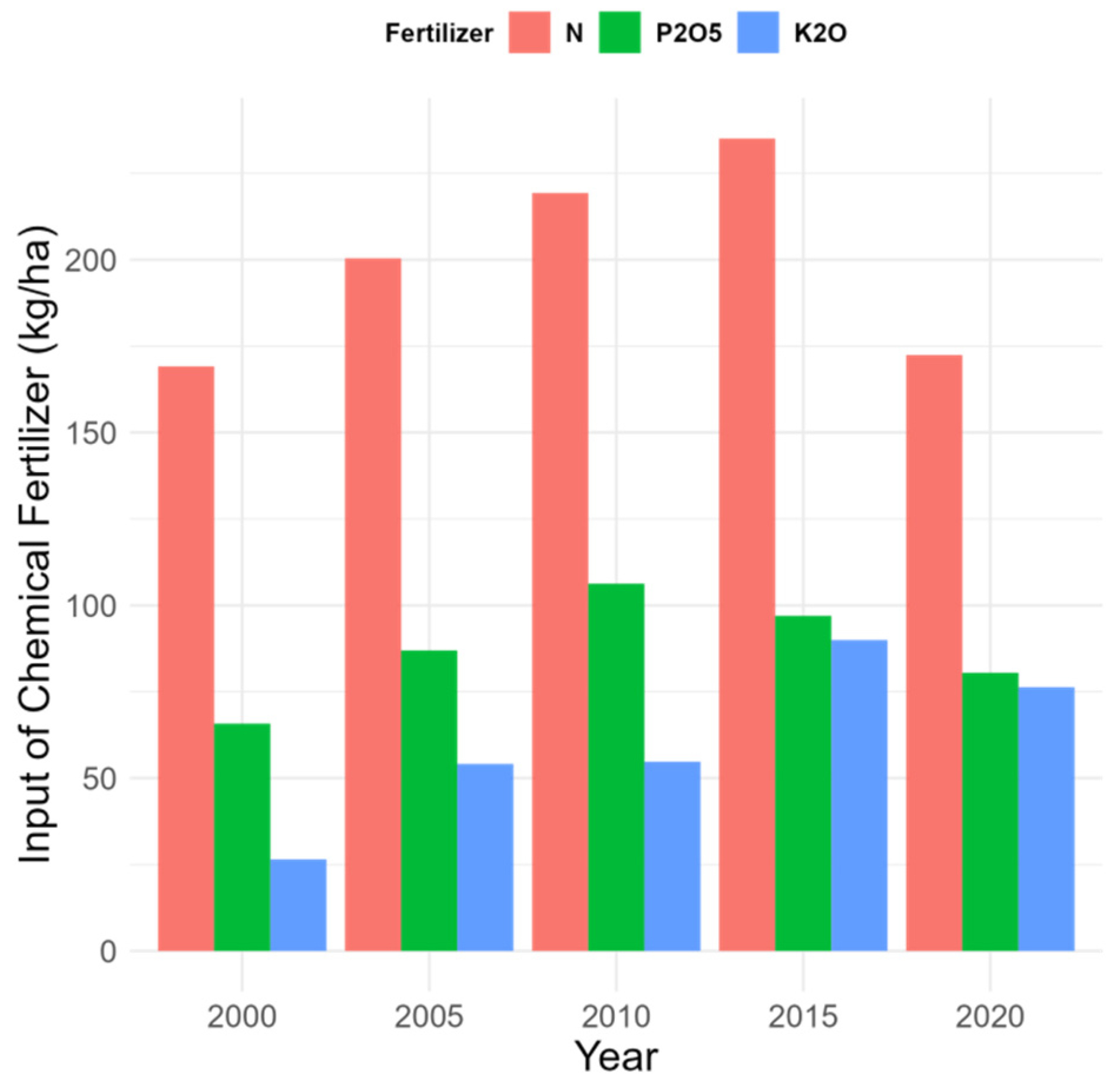
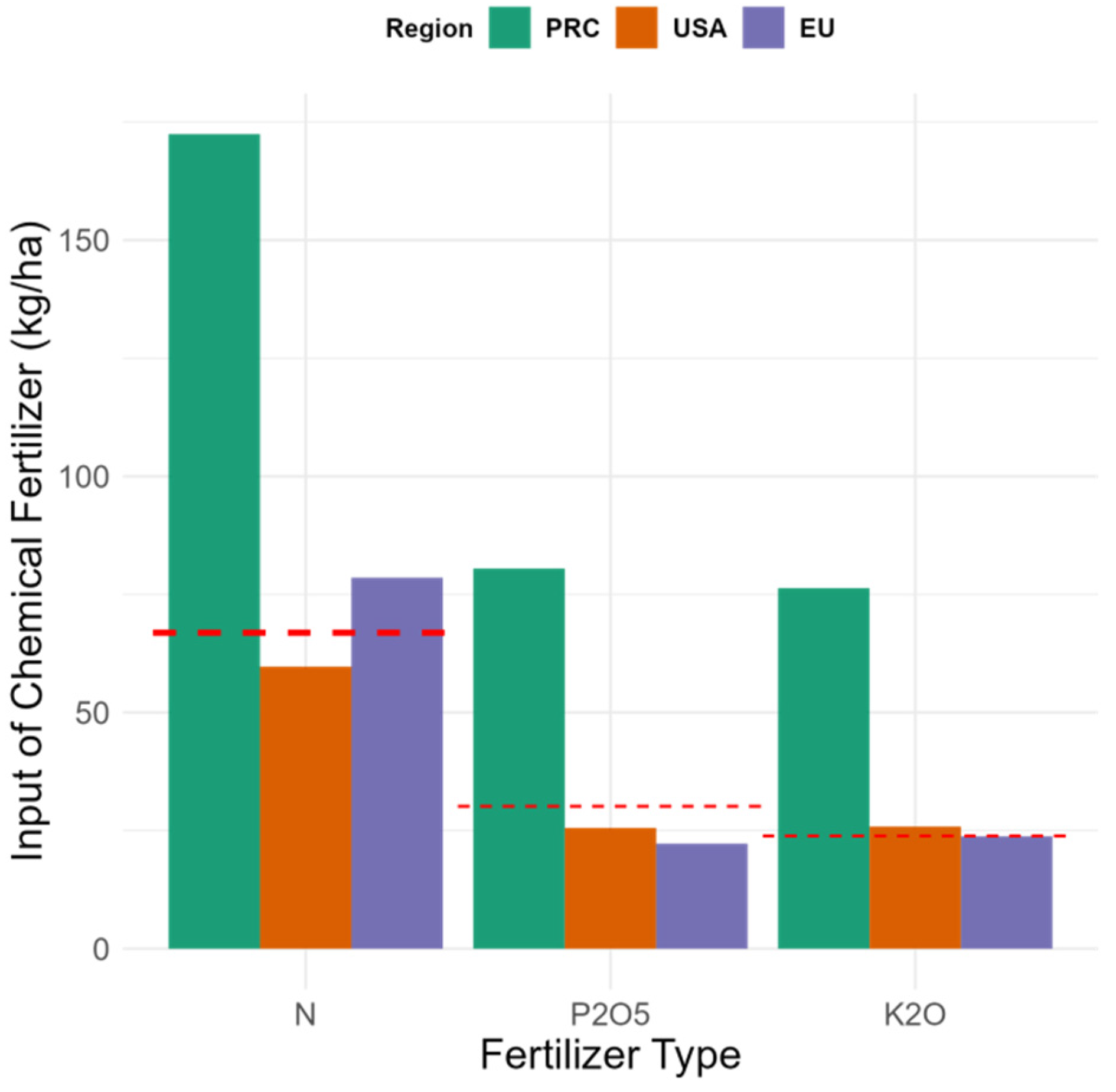

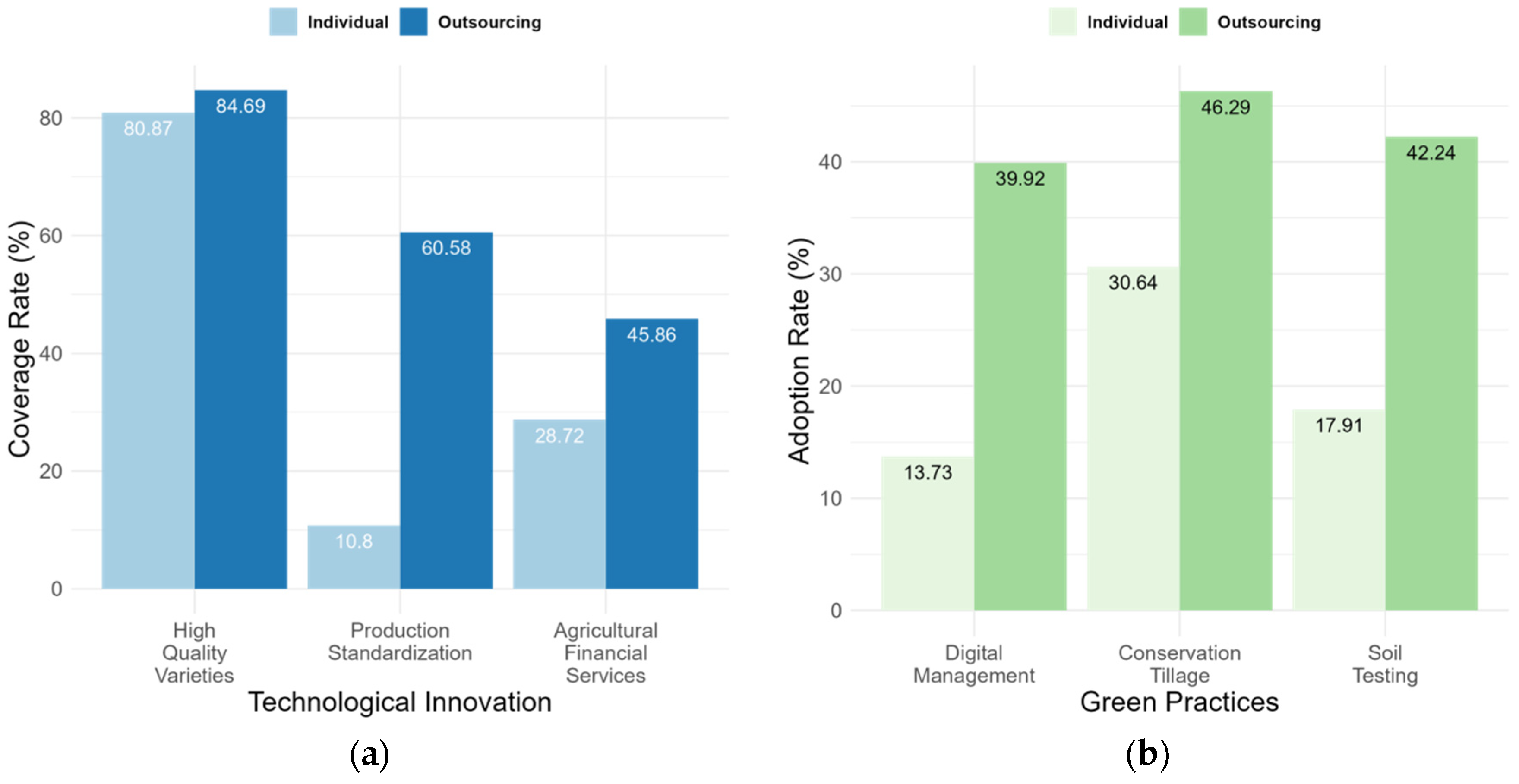
| Performance Indicator | Outsourcing | Individual |
|---|---|---|
| Water Consumption | 98.02 | 61.42 |
| Chemical Fertilizer Application | 22.51 | 14.44 |
| Pesticide Application | 6.98 | 5.4 |
| Carbon Intensity | 422.23 | 503.9 |
Disclaimer/Publisher’s Note: The statements, opinions and data contained in all publications are solely those of the individual author(s) and contributor(s) and not of MDPI and/or the editor(s). MDPI and/or the editor(s) disclaim responsibility for any injury to people or property resulting from any ideas, methods, instructions or products referred to in the content. |
© 2025 by the authors. Licensee MDPI, Basel, Switzerland. This article is an open access article distributed under the terms and conditions of the Creative Commons Attribution (CC BY) license (https://creativecommons.org/licenses/by/4.0/).
Share and Cite
Wang, S.; Yang, Y.; Yin, H.; Zhao, J.; Wang, T.; Yang, X.; Ren, J.; Yin, C. Towards Digital Transformation of Agriculture for Sustainable Development in China: Experience and Lessons Learned. Sustainability 2025, 17, 3756. https://doi.org/10.3390/su17083756
Wang S, Yang Y, Yin H, Zhao J, Wang T, Yang X, Ren J, Yin C. Towards Digital Transformation of Agriculture for Sustainable Development in China: Experience and Lessons Learned. Sustainability. 2025; 17(8):3756. https://doi.org/10.3390/su17083756
Chicago/Turabian StyleWang, Shu, Yueling Yang, Heyao Yin, Jianya Zhao, Ting Wang, Xiaomei Yang, Jing Ren, and Changbin Yin. 2025. "Towards Digital Transformation of Agriculture for Sustainable Development in China: Experience and Lessons Learned" Sustainability 17, no. 8: 3756. https://doi.org/10.3390/su17083756
APA StyleWang, S., Yang, Y., Yin, H., Zhao, J., Wang, T., Yang, X., Ren, J., & Yin, C. (2025). Towards Digital Transformation of Agriculture for Sustainable Development in China: Experience and Lessons Learned. Sustainability, 17(8), 3756. https://doi.org/10.3390/su17083756









